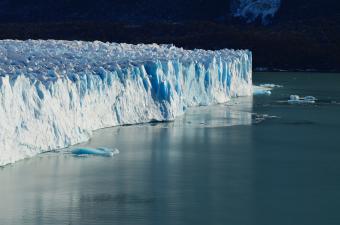Results of a recent paper published in Nature reveal that ice sheets overlying extensive wetlands can release tons of methane to the atmosphere through subglacial rivers.
Ice sheets are currently ignored in global methane budgets used to forecast global warming, yet they may contribute to a rise in the greenhouse gas concentrations during periods of rapid ice sheet retreat.
An international team of researchers led by the University of Bristol, and including NOC engineers, camped for three months next to the Greenland Ice Sheet. There they measured six tons of methane in meltwater running off the Ice Sheet using novel sensors, tested and validated at the NOC for deployment in challenging icy environments - this volume is comparable to the amount of methane released by 100 cows in the same period.
Dr Alex Beaton, an author on the paper from the NOC said “This study has shown that subglacial meltwaters are continuously flushing out methane from below the Greenland Ice Sheet to the atmosphere during the spring and summer. Much of the methane produced under the ice sheet appears to be able to escape to the atmosphere via fast flowing rivers prior to being oxidized to CO2. This research demonstrates the key role that high-resolution data from in situ chemical sensors can play in helping to constrain biogeochemical cycles.”
Co-researcher Dr Elizabeth Bagshaw from Cardiff University added: “The new sensor technologies that we used give us a window into this previously unseen part of the glacial environment. Continuous measurement of meltwater enables us to improve our understanding of how these fascinating systems work and how they impact the rest of the planet.”
Methane gas (CH4) is the third most important greenhouse gas in the atmosphere after water vapour and carbon dioxide (CO2). Although, present in lower concentrations than CO2, methane is approximately 20-28 times more potent. Therefore smaller quantities have the potential to cause disproportionate impacts on atmospheric temperatures. Most of the Earth’s methane is produced by microorganisms that convert organic matter to CH4 in the absence of oxygen, mostly in wetlands and on agricultural land, for instance in the stomachs of cows and in rice paddies. The remainder comes from fossil fuels, like natural gas.
While some methane had been detected previously in Greenland ice cores and in an Antarctic Subglacial Lake, this is the first time that meltwaters produced in spring and summer in large ice sheet catchments have been reported to continuously flush out methane from the ice sheet bed to the atmosphere.
Lead author, Guillaume Lamarche-Gagnon, from Bristol’s School of Geographical Sciences, said: “What is also striking is the fact that we’ve found unequivocal evidence of a widespread subglacial microbial system. Whilst we knew that methane-producing microbes likely were important in subglacial environments, how important and widespread they truly were was debatable. Now we clearly see that active microorganisms, living under kilometres of ice, are not only surviving, but likely impacting other parts of the Earth system. This subglacial methane is essentially a biomarker for life in these isolated habitats.”
Most studies on Arctic methane sources focus on permafrost, because these frozen soils tend to hold large reserves of organic carbon that could be converted to methane when they thaw due to climate warming. This latest study shows that ice sheet beds are also atmospheric methane sources.
Professor Jemma Wadham, Director of Bristol’s Cabot Institute for the Environment, who led the investigation, said: “A key finding is that much of the methane produced beneath the ice likely escapes the Greenland Ice Sheet in large, fast flowing rivers before it can be oxidized to CO2, a typical fate for methane gas which normally reduces its greenhouse warming potency.”
With Antarctica holding the largest ice mass on the planet, researchers say their findings make a case for turning the spotlight to the south. Mr Lamarche-Gagnon added: “Several orders of magnitude more methane has been hypothesized to be capped beneath the Antarctic Ice Sheet than beneath Arctic ice-masses. Like we did in Greenland, it’s time to put more robust numbers on the theory.”
This study was a collaboration between Bristol University, Charles University (Czechia), the National Oceanography Centre, Newcastle University (UK), the University of Toronto (Canada), the Université Libre de Bruxelles (Belgium), Cardiff University (UK), and Kongsberg Maritime Contros (Germany). It was funded by the Natural Environment Research Council (NERC), with additional funds from the Leverhulme Trust, the Czech Science Foundation, the Natural Sciences and Engineering Research Council of Canada, and the Fond de Recherche Nature et Technologies du Québec (Canada).

